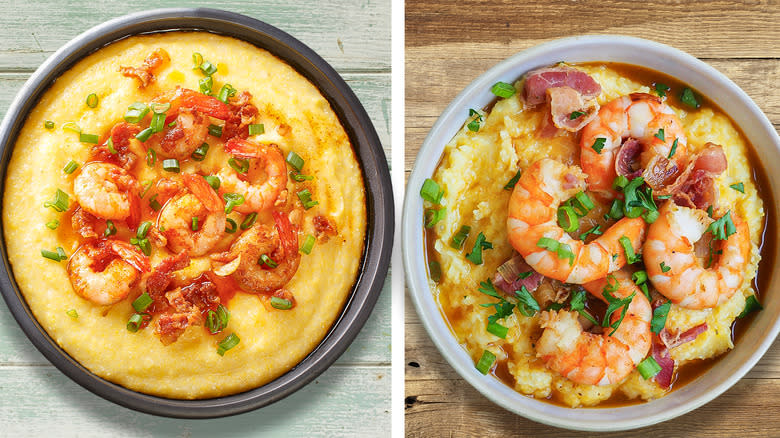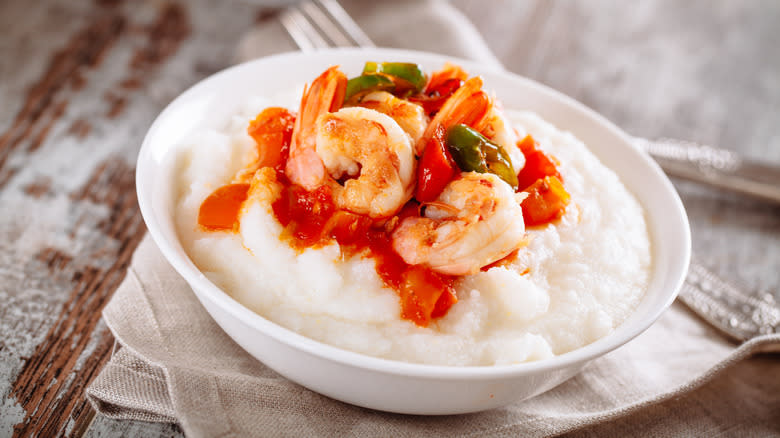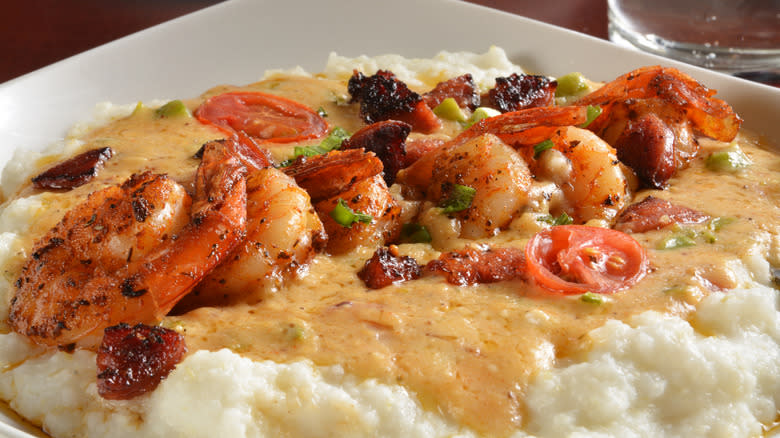Lowcountry Shrimp And Grits Vs New Orleans-Style: What's The Difference?

Shrimp and grits is an iconic southern dish with a nearly endless variety of recipes. What stays the same, of course, is the bed of creamy, ground corn porridge topped with a tangle of tender crustaceans. Nearly everything else is subject to change depending on your location or just personal preference. The Lowcountry — that marshy coastal area of South Carolina and Georgia — is said to be the origin of shrimp and grits, and that would make sense considering the plentiful amounts of both ingredients found in the area. Historically a breakfast meal, the dish is now more likely to be found at lunch or dinner, and as it has grown in popularity throughout the southern U.S., restaurants across the region have adapted the dish to suit local tastes.
Two versions stand out: The simplicity of the original Lowcountry style with its subtle bacon-laced shrimp saute and New Orleans style, encompassing the holy trinity of onion, celery, and bell pepper in a spice-laden sauce, and possibly Tasso ham or andouille sausage standing in for the bacon.
Read more: 15 Different Ways To Cook Fish
What Is Lowcountry Shrimp And Grits

Originally a humble dish representing low-cost ingredients easy to find along southern rivers and coastal areas, the history of shrimp and grits may even stretch back to Africa through the enslaved people who were brought to Charleston and other port cities. Local Lowcountry cooks prepared the dish at home as a morning meal, where the grits provided a filling base for nutritious, high-protein shrimp that fueled a hard day's work. In the 1980s the dish got national attention when it was highlighted by New York Times food writer Craig Claiborne, and it began to appear on restaurant menus throughout the region.
Lowcountry shrimp and grits may contain tomatoes, mushrooms, green onion, and bacon, and even though it appears on the finest restaurant menus throughout the coastal area, the simple and clean flavors of local shrimp and corn are the stars of the plate. Local ground corn grits might be a simple simmered pot of home-style porridge leaving the spotlight on that shrimp topping, or simmered with milk and enriched with cheese for added creaminess and flavor.
What Is New Orleans-Style Shrimp And Grits

Shrimp and grits in New Orleans is decidedly a more upscale affair than the low-key coastal plate served in Lowcountry homes. Creole and Cajun cooks have added their flair to the dish creating southern fusion versions that have more emphasis on creating a sauce to top the grits. Many chefs also add local meats like Tasso ham and andouille sausage to the plate along with the Gulf shrimp.
The sauce might either start with a brown roux or a more Creole tomato base including that Cajun trinity of vegetables: Onion, celery, and bell pepper. Cherry tomatoes, corn, or other vegetables could be on the plate depending on the season. The dish is likely to feature a dose of Cajun or Creole seasoning, too — red and black peppers, thyme, parsley, or oregano and a dash or two of Tabasco or Crystal hot sauce could be in the mix. You might also find a richer version of grits, with more cream or multiple cheese varieties stirred in to create an elevated NOLA experience. Although the origin of this delicious Lowcountry plate was the basic necessity to feed hungry stomachs with easy-to-find, inexpensive ingredients, the dish has become an elevated example of the best local ingredients wherever it's served.
Read the original article on Tasting Table.

